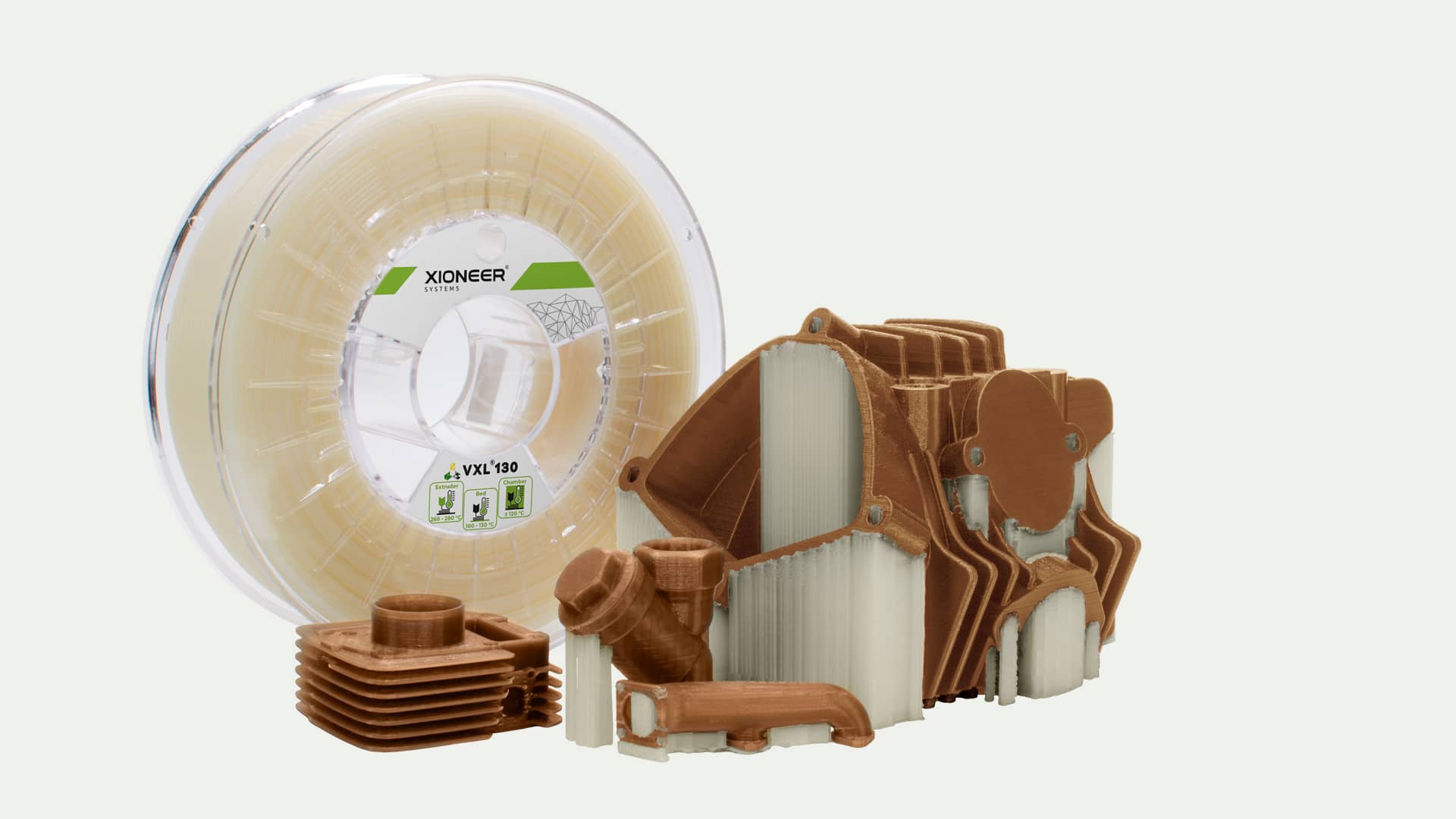Support materials let you 3D print complex structures. These materials, however, also have a hard job: they have to adapt to the printing conditions of your model material. Besides, you want to easily remove them in the end.
So the choice of the right support material is not easy. But this choice is very important.
There are two paths you can follow. First, print break-away support and remove it manually afterward. But there is a second choice: pick soluble support material and dissolve it in the end. I prefer the second option because it is easier and delivers more precise results.
VXL is new soluble support material. But what places VXL ahead of the pack?
1. Excellent Adhesion
VXL adheres very well to most model materials and printing surfaces. It even works well with the non-sticky Polycarbonate (PC).
One disadvantage of VXL: it bonds too well to common carbon fiber build-plates. The epoxy resin contained in these plates has such a high adherence to VXL that you will barely get your supports of the surface. However, should this happen to you (as it happened to me): simply place your plate with supports into a solvent bath. The solvent will dissolve VXL without a trace.
Here is another tip: use VXL as a raft layer between your model and the printing surface. If you are not sure whether your model material will bond well to the printing surface, you can use a raft from VXL and create the actual model on top of it.
2. Prevents Warping
You know the nemesis of every 3D printer user: warping.
Warping is the effect of thermal distortion once the printed material cools down. It morphs flat surfaces into dishes. This becomes prominent for large print objects. The bigger the part, the stronger it warps.
Now, because VXL bonds so well to your model, it counteracts the forces that warp your part. Scaffolds made from VXL hold your model together inside your 3D printer.
3. Dissolves Quickly
Yes, 3D printing takes time. Sometimes, much longer than we wish for.
An intricate model will consume many hours until our printer processes its last line of G-Code. However, printing alone is often not the end of the struggle. After the print job is complete, you still need to remove your supports. So we often dream of making this last step as simple and as quick as possible.
Some support materials offer relief. Break-away supports can be removed very quickly. But break-away structures are tedious. They can get you busy for hours removing those small bits and pieces stuck inside the part. Besides, break-away supports typically leave blemished surfaces on your model.
VXL scores better because you can simply dissolve it in a warm bath with a solvent called VXL-EX. When I asked our chemist to explain to me what this “magic solvent” was, he gave me a straightforward answer: “It’s no magic. In fact, the solvent is very similar to the washing powder we all use to clean our laundry.” So is it really that safe? He replied: “As safe as your laundry detergent.”
The best part: VXL dissolves faster than other soluble support materials we tested. But to get the best performance, a washing station like the Vortex EZ can truly save you hours of waiting for your supports to dissolve. The device keeps the fluid whirling at the right temperature washing away every last bit of support.
4. Easy to Store
“How do I store my filament?” This is the question most 3D printing enthusiasts ask themselves when they receive a new spool of material. And it’s not as simple as it seems. Moreover, the storage of support materials is a particular challenge.
Water-soluble materials like PVA and BVOH soak up moisture fast and in large amounts. This makes sense because materials that were created to dissolve in water will also naturally absorb humidity from the air too.
But here comes the worst part. This moisture can damage the polymer chains. This becomes apparent during the melting process in the nozzle. The support material loses some of its properties affecting its ability to do its job: support your models. In the end, it can lose its ability to bond to your model too.
But before we explain how VXL solves this problem, let’s see what happens if moisture invades your support material. You cannot see moisture by looking at your filament spool. But you can see its effects once you print with a “wet” filament.
When your extruder heats the plastic, the water contained inside begins to boil and evaporate. This results in little steam bubbles emerging inside extruded material. These bubbles can be so small that you can’t detect them with the naked eye. But they interfere with your print job. In the worst-case, the extrusion becomes inconsistent, and your print job fails.
Like any other thermoplastic material, VXL absorbs moisture too. The good news is, VXL absorbs much less water than other support materials. Therefore, moisture hardly affects your print quality and VXL’s shelf-life. So you can leave your spools of VXL lying around much longer than other materials without having to worry about moisture damage.
In general, we recommend storing all your materials (model and support) as dry as possible. Because this is how the professionals (including injection molders) do it. Check out our filament storage cabinet DryBox EZ – it even protects your materials while you print with them.
5. Clean Nozzles
We often get this question: “How is VXL different from PVA and other water-soluble materials?”
The short answer is: VXL is an entirely different chemical compound from all other soluble materials on the market. It has no PVA or similar components inside. This has a major advantage for your 3D printing experience.
PVA has this nasty property: it burns quickly once you heat it up to its melting temperature. The molecules of PVA, BVOH, and many other water-soluble materials crystalize under heat. The result: the support material becomes harder inside your nozzle. So in the end, you are faced with a clogged nozzle, failed print-job, and cleaning the mess inside your nozzle afterward.
But VXL is much more stable at high temperatures. So even if you print with VXL for prolonged periods of time, it will not clog your nozzle.
Besides, we designed four different versions of VXL for different printing temperatures of your 3D printer chamber and support removal station. So you will always find the ideal VXL for your printing project.
6. Tuned Temperatures
The support material should work under the same conditions as the model material inside your 3D printer. This makes sense because you print both materials on the same printer, in the same printing chamber, and on the same printing surface.
Here is the thing about soluble support materials: Some will dissolve in pure water, while others, like VXL, dissolve in a special solvent. But the temperature of your solution medium plays an important role in the quick and effective dissolution of supports. So the temperature should not be too high. Ideally, it should be low enough not to affect your model material.
VXL comes in four versions with temperature properties that are designed to fit most model materials. This ensures that you don’t damage your model when dissolving your supports in a bath.
The Right VXL for Your Printing Project
Are you interested in testing VXL for your next 3D printing project? Check out our VXL-GO starter kit which has everything you need to get amazing supports!
Happy printing!




